GEP 10: A Comprehensive Report on Global Environmental Protection
VerifiedAdded on 2023/01/12
|10
|2386
|44
Report
AI Summary
This report provides a comprehensive overview of Global Environmental Protection (GEP), focusing on its legal and policy aspects. It begins by defining GEP and its objectives, emphasizing the need for international cooperation to address climate change, biodiversity loss, and other environmental challenges. The report traces the development of GEP, highlighting key milestones like the Rio Earth Summit of 1992. It then explores the importance of ecologically sustainable development, including intergenerational and intragenerational equity, as well as the precautionary principle. The report examines responses to GEP from nation-states, the United Nations, and international instruments. It also discusses the roles of courts, conferences, intergovernmental and non-governmental organizations, and the media in environmental protection, with specific examples from Australia. The report concludes by analyzing contemporary issues, including the role of law in addressing global environmental threats, legal responses to resource conflicts, Australia's responses to international initiatives, and the barriers to achieving an international response to GEP, like poor monitoring and evaluation systems. The report uses various references to support its arguments.
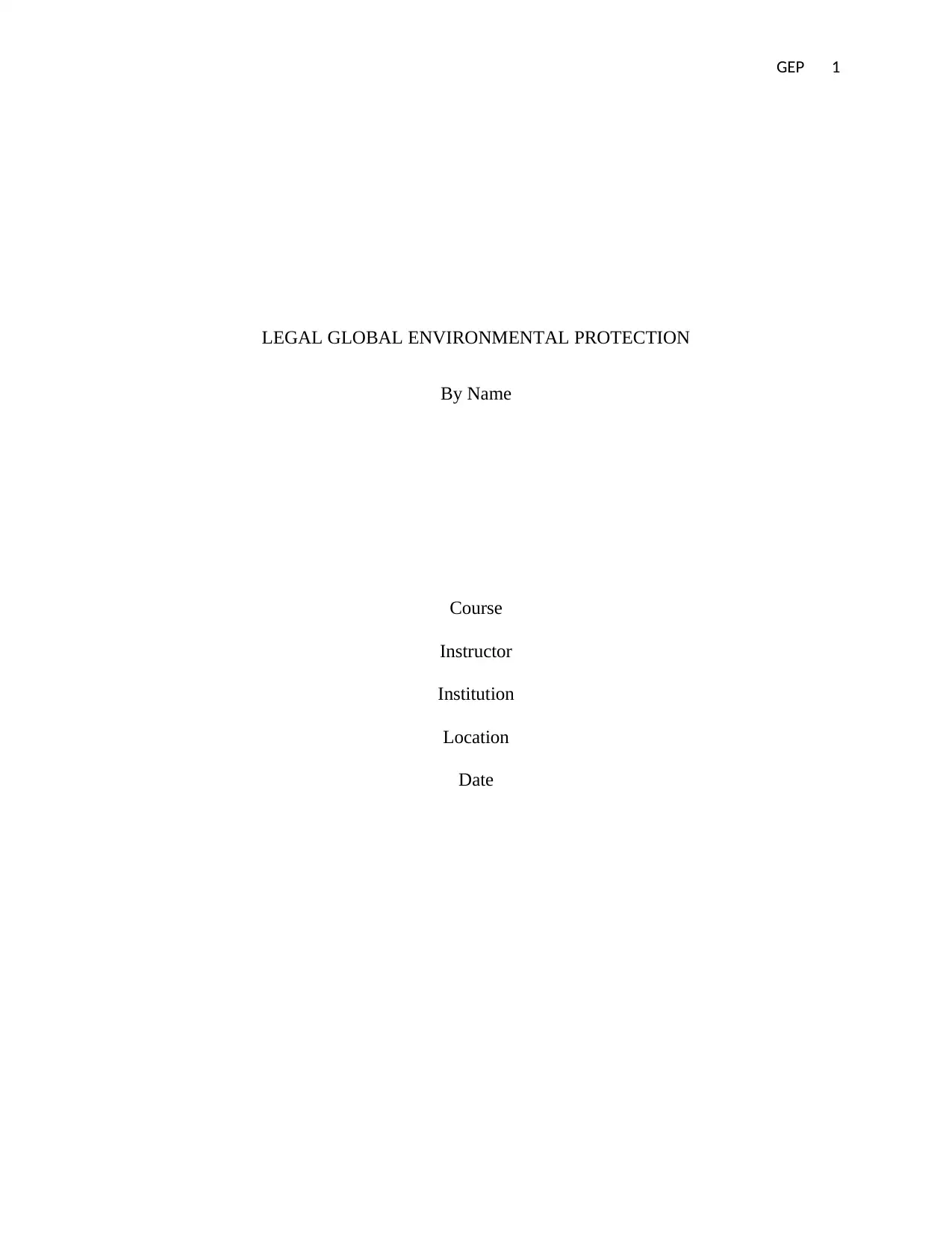
GEP 1
LEGAL GLOBAL ENVIRONMENTAL PROTECTION
By Name
Course
Instructor
Institution
Location
Date
LEGAL GLOBAL ENVIRONMENTAL PROTECTION
By Name
Course
Instructor
Institution
Location
Date
Paraphrase This Document
Need a fresh take? Get an instant paraphrase of this document with our AI Paraphraser
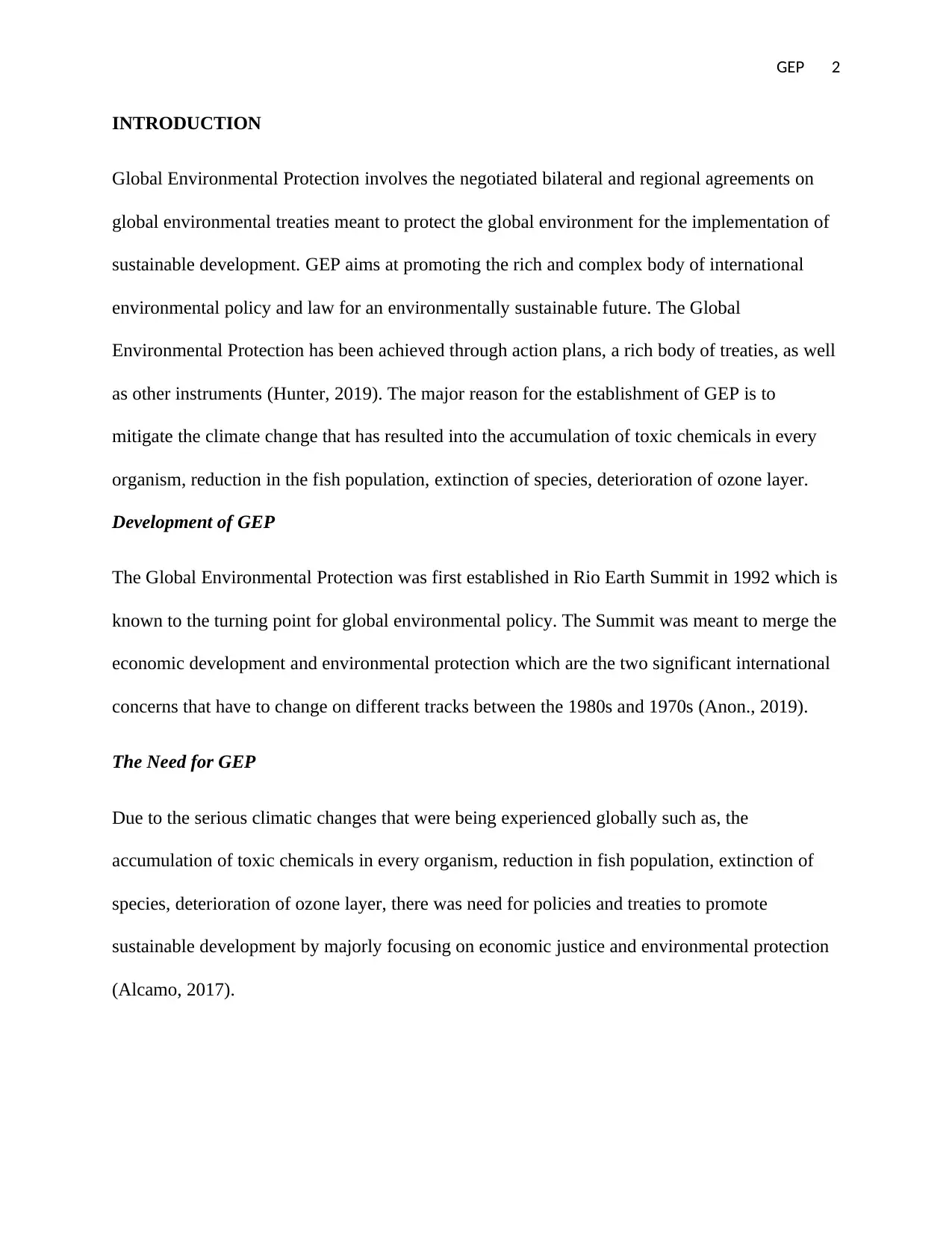
GEP 2
INTRODUCTION
Global Environmental Protection involves the negotiated bilateral and regional agreements on
global environmental treaties meant to protect the global environment for the implementation of
sustainable development. GEP aims at promoting the rich and complex body of international
environmental policy and law for an environmentally sustainable future. The Global
Environmental Protection has been achieved through action plans, a rich body of treaties, as well
as other instruments (Hunter, 2019). The major reason for the establishment of GEP is to
mitigate the climate change that has resulted into the accumulation of toxic chemicals in every
organism, reduction in the fish population, extinction of species, deterioration of ozone layer.
Development of GEP
The Global Environmental Protection was first established in Rio Earth Summit in 1992 which is
known to the turning point for global environmental policy. The Summit was meant to merge the
economic development and environmental protection which are the two significant international
concerns that have to change on different tracks between the 1980s and 1970s (Anon., 2019).
The Need for GEP
Due to the serious climatic changes that were being experienced globally such as, the
accumulation of toxic chemicals in every organism, reduction in fish population, extinction of
species, deterioration of ozone layer, there was need for policies and treaties to promote
sustainable development by majorly focusing on economic justice and environmental protection
(Alcamo, 2017).
INTRODUCTION
Global Environmental Protection involves the negotiated bilateral and regional agreements on
global environmental treaties meant to protect the global environment for the implementation of
sustainable development. GEP aims at promoting the rich and complex body of international
environmental policy and law for an environmentally sustainable future. The Global
Environmental Protection has been achieved through action plans, a rich body of treaties, as well
as other instruments (Hunter, 2019). The major reason for the establishment of GEP is to
mitigate the climate change that has resulted into the accumulation of toxic chemicals in every
organism, reduction in the fish population, extinction of species, deterioration of ozone layer.
Development of GEP
The Global Environmental Protection was first established in Rio Earth Summit in 1992 which is
known to the turning point for global environmental policy. The Summit was meant to merge the
economic development and environmental protection which are the two significant international
concerns that have to change on different tracks between the 1980s and 1970s (Anon., 2019).
The Need for GEP
Due to the serious climatic changes that were being experienced globally such as, the
accumulation of toxic chemicals in every organism, reduction in fish population, extinction of
species, deterioration of ozone layer, there was need for policies and treaties to promote
sustainable development by majorly focusing on economic justice and environmental protection
(Alcamo, 2017).
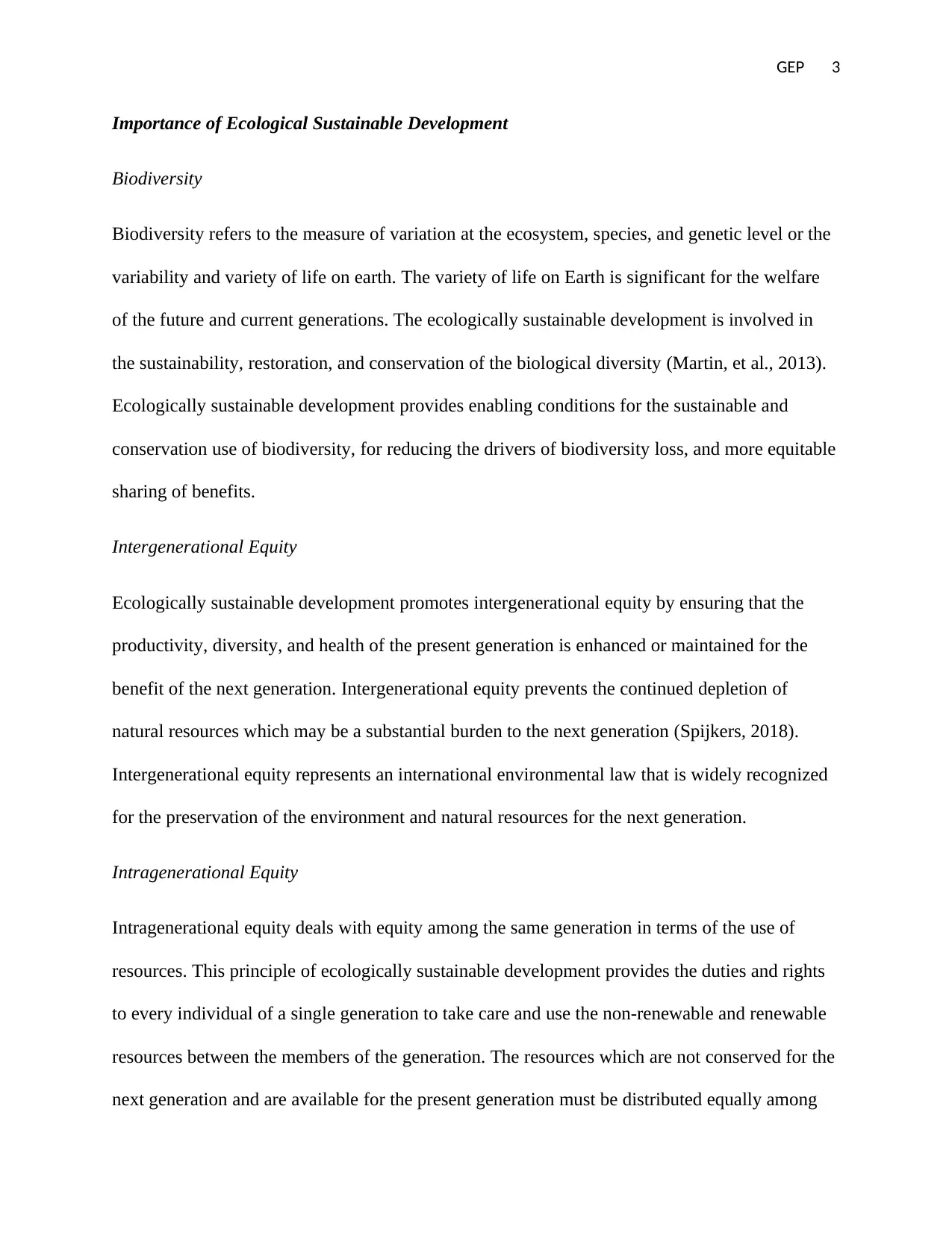
GEP 3
Importance of Ecological Sustainable Development
Biodiversity
Biodiversity refers to the measure of variation at the ecosystem, species, and genetic level or the
variability and variety of life on earth. The variety of life on Earth is significant for the welfare
of the future and current generations. The ecologically sustainable development is involved in
the sustainability, restoration, and conservation of the biological diversity (Martin, et al., 2013).
Ecologically sustainable development provides enabling conditions for the sustainable and
conservation use of biodiversity, for reducing the drivers of biodiversity loss, and more equitable
sharing of benefits.
Intergenerational Equity
Ecologically sustainable development promotes intergenerational equity by ensuring that the
productivity, diversity, and health of the present generation is enhanced or maintained for the
benefit of the next generation. Intergenerational equity prevents the continued depletion of
natural resources which may be a substantial burden to the next generation (Spijkers, 2018).
Intergenerational equity represents an international environmental law that is widely recognized
for the preservation of the environment and natural resources for the next generation.
Intragenerational Equity
Intragenerational equity deals with equity among the same generation in terms of the use of
resources. This principle of ecologically sustainable development provides the duties and rights
to every individual of a single generation to take care and use the non-renewable and renewable
resources between the members of the generation. The resources which are not conserved for the
next generation and are available for the present generation must be distributed equally among
Importance of Ecological Sustainable Development
Biodiversity
Biodiversity refers to the measure of variation at the ecosystem, species, and genetic level or the
variability and variety of life on earth. The variety of life on Earth is significant for the welfare
of the future and current generations. The ecologically sustainable development is involved in
the sustainability, restoration, and conservation of the biological diversity (Martin, et al., 2013).
Ecologically sustainable development provides enabling conditions for the sustainable and
conservation use of biodiversity, for reducing the drivers of biodiversity loss, and more equitable
sharing of benefits.
Intergenerational Equity
Ecologically sustainable development promotes intergenerational equity by ensuring that the
productivity, diversity, and health of the present generation is enhanced or maintained for the
benefit of the next generation. Intergenerational equity prevents the continued depletion of
natural resources which may be a substantial burden to the next generation (Spijkers, 2018).
Intergenerational equity represents an international environmental law that is widely recognized
for the preservation of the environment and natural resources for the next generation.
Intragenerational Equity
Intragenerational equity deals with equity among the same generation in terms of the use of
resources. This principle of ecologically sustainable development provides the duties and rights
to every individual of a single generation to take care and use the non-renewable and renewable
resources between the members of the generation. The resources which are not conserved for the
next generation and are available for the present generation must be distributed equally among
⊘ This is a preview!⊘
Do you want full access?
Subscribe today to unlock all pages.

Trusted by 1+ million students worldwide
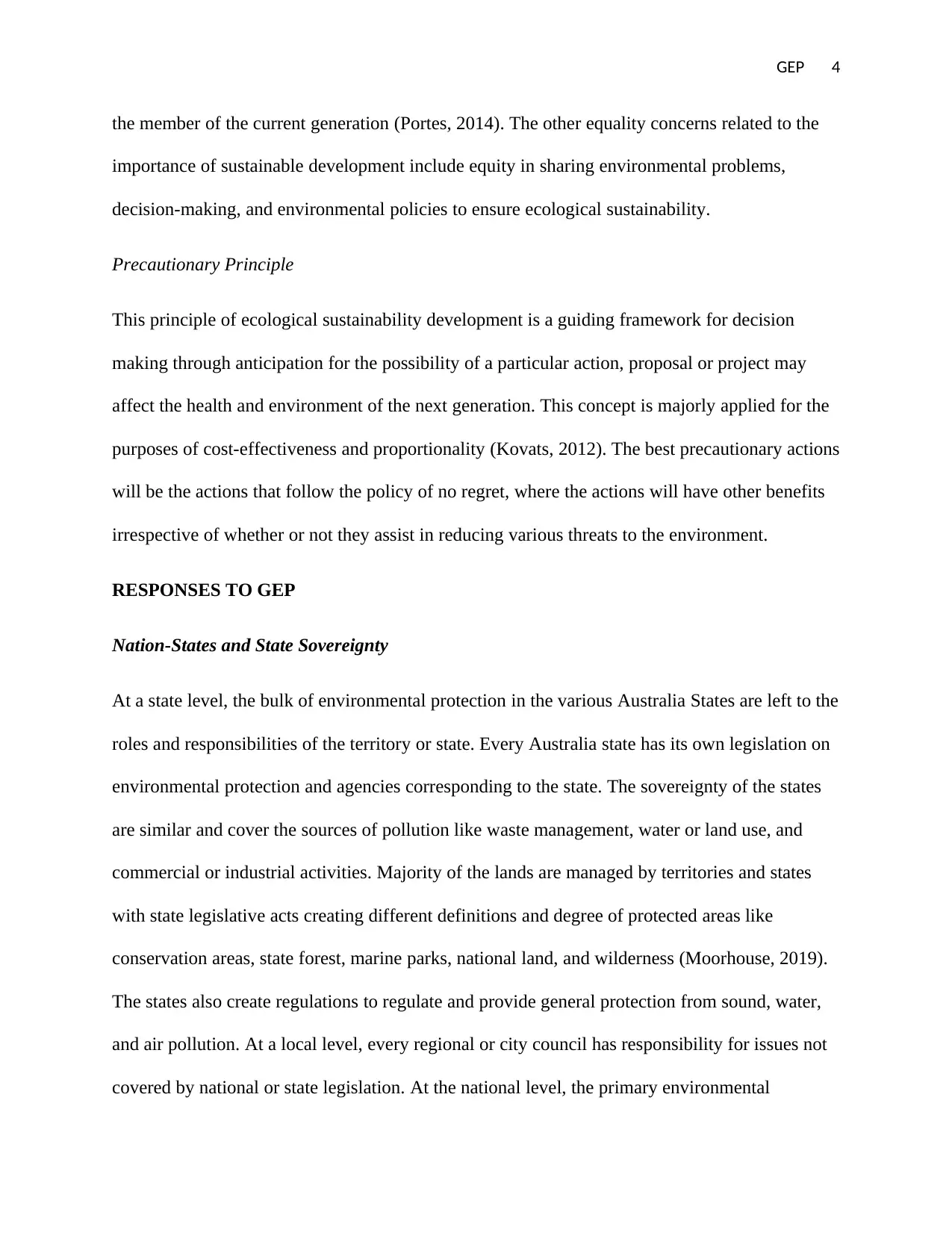
GEP 4
the member of the current generation (Portes, 2014). The other equality concerns related to the
importance of sustainable development include equity in sharing environmental problems,
decision-making, and environmental policies to ensure ecological sustainability.
Precautionary Principle
This principle of ecological sustainability development is a guiding framework for decision
making through anticipation for the possibility of a particular action, proposal or project may
affect the health and environment of the next generation. This concept is majorly applied for the
purposes of cost-effectiveness and proportionality (Kovats, 2012). The best precautionary actions
will be the actions that follow the policy of no regret, where the actions will have other benefits
irrespective of whether or not they assist in reducing various threats to the environment.
RESPONSES TO GEP
Nation-States and State Sovereignty
At a state level, the bulk of environmental protection in the various Australia States are left to the
roles and responsibilities of the territory or state. Every Australia state has its own legislation on
environmental protection and agencies corresponding to the state. The sovereignty of the states
are similar and cover the sources of pollution like waste management, water or land use, and
commercial or industrial activities. Majority of the lands are managed by territories and states
with state legislative acts creating different definitions and degree of protected areas like
conservation areas, state forest, marine parks, national land, and wilderness (Moorhouse, 2019).
The states also create regulations to regulate and provide general protection from sound, water,
and air pollution. At a local level, every regional or city council has responsibility for issues not
covered by national or state legislation. At the national level, the primary environmental
the member of the current generation (Portes, 2014). The other equality concerns related to the
importance of sustainable development include equity in sharing environmental problems,
decision-making, and environmental policies to ensure ecological sustainability.
Precautionary Principle
This principle of ecological sustainability development is a guiding framework for decision
making through anticipation for the possibility of a particular action, proposal or project may
affect the health and environment of the next generation. This concept is majorly applied for the
purposes of cost-effectiveness and proportionality (Kovats, 2012). The best precautionary actions
will be the actions that follow the policy of no regret, where the actions will have other benefits
irrespective of whether or not they assist in reducing various threats to the environment.
RESPONSES TO GEP
Nation-States and State Sovereignty
At a state level, the bulk of environmental protection in the various Australia States are left to the
roles and responsibilities of the territory or state. Every Australia state has its own legislation on
environmental protection and agencies corresponding to the state. The sovereignty of the states
are similar and cover the sources of pollution like waste management, water or land use, and
commercial or industrial activities. Majority of the lands are managed by territories and states
with state legislative acts creating different definitions and degree of protected areas like
conservation areas, state forest, marine parks, national land, and wilderness (Moorhouse, 2019).
The states also create regulations to regulate and provide general protection from sound, water,
and air pollution. At a local level, every regional or city council has responsibility for issues not
covered by national or state legislation. At the national level, the primary environmental
Paraphrase This Document
Need a fresh take? Get an instant paraphrase of this document with our AI Paraphraser
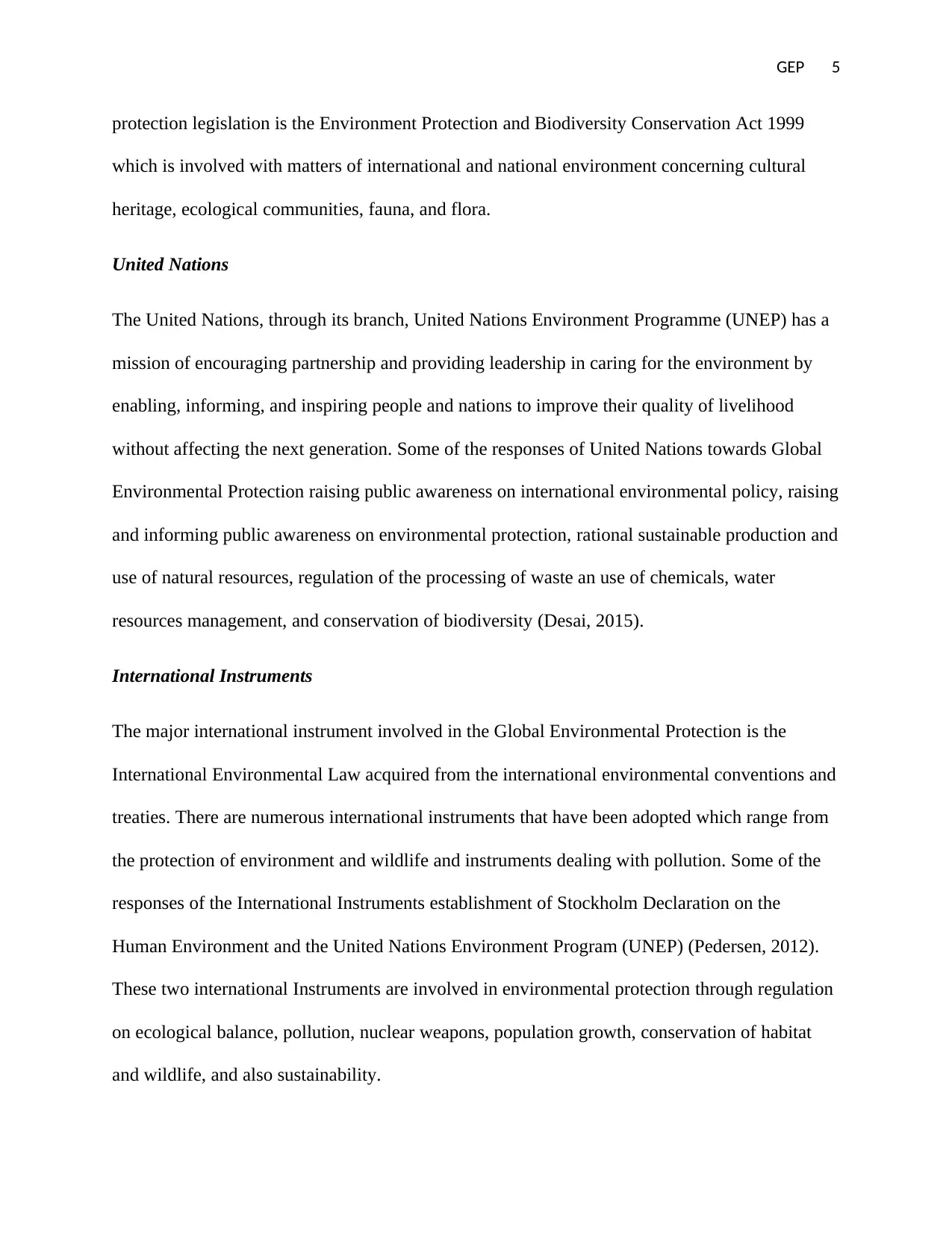
GEP 5
protection legislation is the Environment Protection and Biodiversity Conservation Act 1999
which is involved with matters of international and national environment concerning cultural
heritage, ecological communities, fauna, and flora.
United Nations
The United Nations, through its branch, United Nations Environment Programme (UNEP) has a
mission of encouraging partnership and providing leadership in caring for the environment by
enabling, informing, and inspiring people and nations to improve their quality of livelihood
without affecting the next generation. Some of the responses of United Nations towards Global
Environmental Protection raising public awareness on international environmental policy, raising
and informing public awareness on environmental protection, rational sustainable production and
use of natural resources, regulation of the processing of waste an use of chemicals, water
resources management, and conservation of biodiversity (Desai, 2015).
International Instruments
The major international instrument involved in the Global Environmental Protection is the
International Environmental Law acquired from the international environmental conventions and
treaties. There are numerous international instruments that have been adopted which range from
the protection of environment and wildlife and instruments dealing with pollution. Some of the
responses of the International Instruments establishment of Stockholm Declaration on the
Human Environment and the United Nations Environment Program (UNEP) (Pedersen, 2012).
These two international Instruments are involved in environmental protection through regulation
on ecological balance, pollution, nuclear weapons, population growth, conservation of habitat
and wildlife, and also sustainability.
protection legislation is the Environment Protection and Biodiversity Conservation Act 1999
which is involved with matters of international and national environment concerning cultural
heritage, ecological communities, fauna, and flora.
United Nations
The United Nations, through its branch, United Nations Environment Programme (UNEP) has a
mission of encouraging partnership and providing leadership in caring for the environment by
enabling, informing, and inspiring people and nations to improve their quality of livelihood
without affecting the next generation. Some of the responses of United Nations towards Global
Environmental Protection raising public awareness on international environmental policy, raising
and informing public awareness on environmental protection, rational sustainable production and
use of natural resources, regulation of the processing of waste an use of chemicals, water
resources management, and conservation of biodiversity (Desai, 2015).
International Instruments
The major international instrument involved in the Global Environmental Protection is the
International Environmental Law acquired from the international environmental conventions and
treaties. There are numerous international instruments that have been adopted which range from
the protection of environment and wildlife and instruments dealing with pollution. Some of the
responses of the International Instruments establishment of Stockholm Declaration on the
Human Environment and the United Nations Environment Program (UNEP) (Pedersen, 2012).
These two international Instruments are involved in environmental protection through regulation
on ecological balance, pollution, nuclear weapons, population growth, conservation of habitat
and wildlife, and also sustainability.
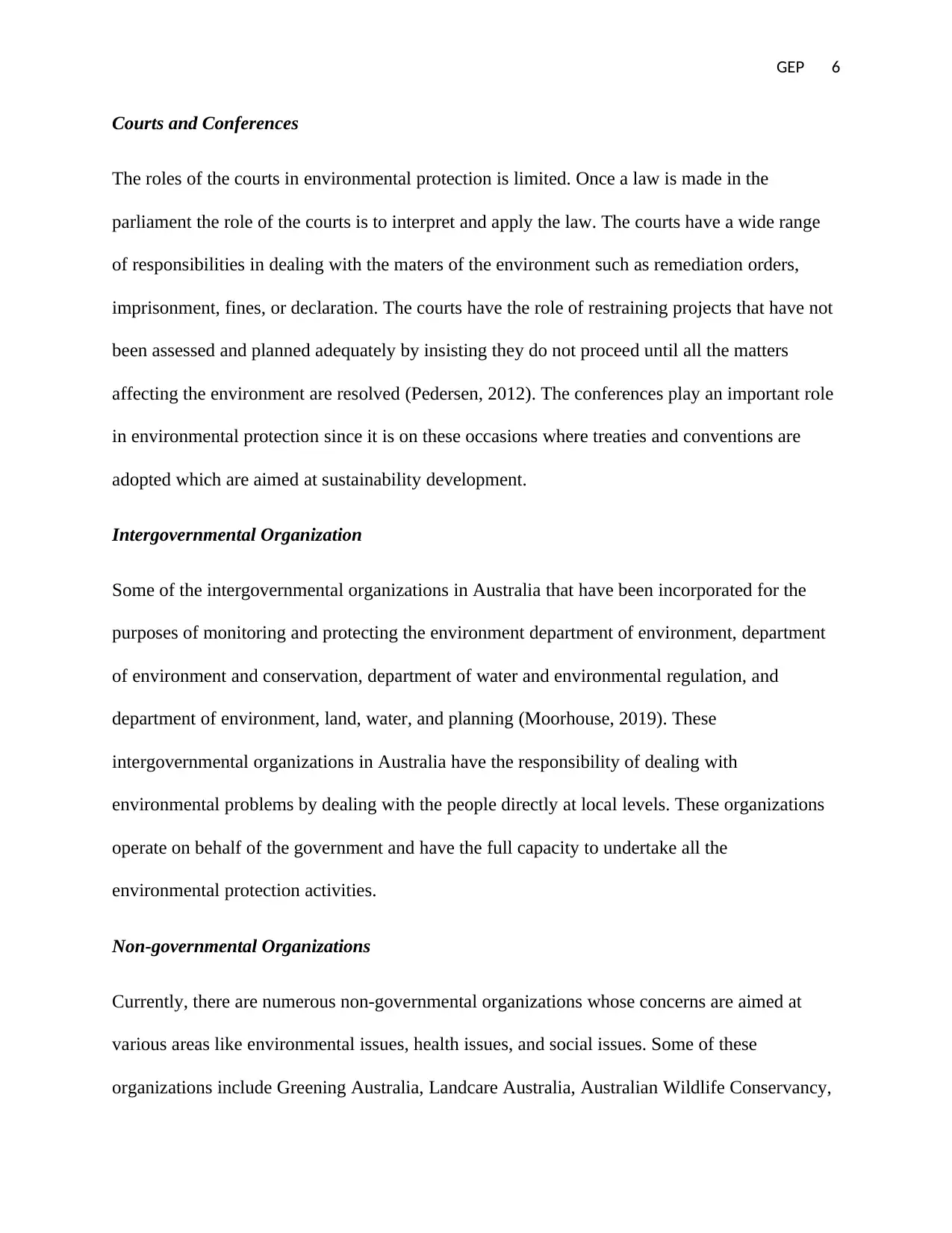
GEP 6
Courts and Conferences
The roles of the courts in environmental protection is limited. Once a law is made in the
parliament the role of the courts is to interpret and apply the law. The courts have a wide range
of responsibilities in dealing with the maters of the environment such as remediation orders,
imprisonment, fines, or declaration. The courts have the role of restraining projects that have not
been assessed and planned adequately by insisting they do not proceed until all the matters
affecting the environment are resolved (Pedersen, 2012). The conferences play an important role
in environmental protection since it is on these occasions where treaties and conventions are
adopted which are aimed at sustainability development.
Intergovernmental Organization
Some of the intergovernmental organizations in Australia that have been incorporated for the
purposes of monitoring and protecting the environment department of environment, department
of environment and conservation, department of water and environmental regulation, and
department of environment, land, water, and planning (Moorhouse, 2019). These
intergovernmental organizations in Australia have the responsibility of dealing with
environmental problems by dealing with the people directly at local levels. These organizations
operate on behalf of the government and have the full capacity to undertake all the
environmental protection activities.
Non-governmental Organizations
Currently, there are numerous non-governmental organizations whose concerns are aimed at
various areas like environmental issues, health issues, and social issues. Some of these
organizations include Greening Australia, Landcare Australia, Australian Wildlife Conservancy,
Courts and Conferences
The roles of the courts in environmental protection is limited. Once a law is made in the
parliament the role of the courts is to interpret and apply the law. The courts have a wide range
of responsibilities in dealing with the maters of the environment such as remediation orders,
imprisonment, fines, or declaration. The courts have the role of restraining projects that have not
been assessed and planned adequately by insisting they do not proceed until all the matters
affecting the environment are resolved (Pedersen, 2012). The conferences play an important role
in environmental protection since it is on these occasions where treaties and conventions are
adopted which are aimed at sustainability development.
Intergovernmental Organization
Some of the intergovernmental organizations in Australia that have been incorporated for the
purposes of monitoring and protecting the environment department of environment, department
of environment and conservation, department of water and environmental regulation, and
department of environment, land, water, and planning (Moorhouse, 2019). These
intergovernmental organizations in Australia have the responsibility of dealing with
environmental problems by dealing with the people directly at local levels. These organizations
operate on behalf of the government and have the full capacity to undertake all the
environmental protection activities.
Non-governmental Organizations
Currently, there are numerous non-governmental organizations whose concerns are aimed at
various areas like environmental issues, health issues, and social issues. Some of these
organizations include Greening Australia, Landcare Australia, Australian Wildlife Conservancy,
⊘ This is a preview!⊘
Do you want full access?
Subscribe today to unlock all pages.

Trusted by 1+ million students worldwide
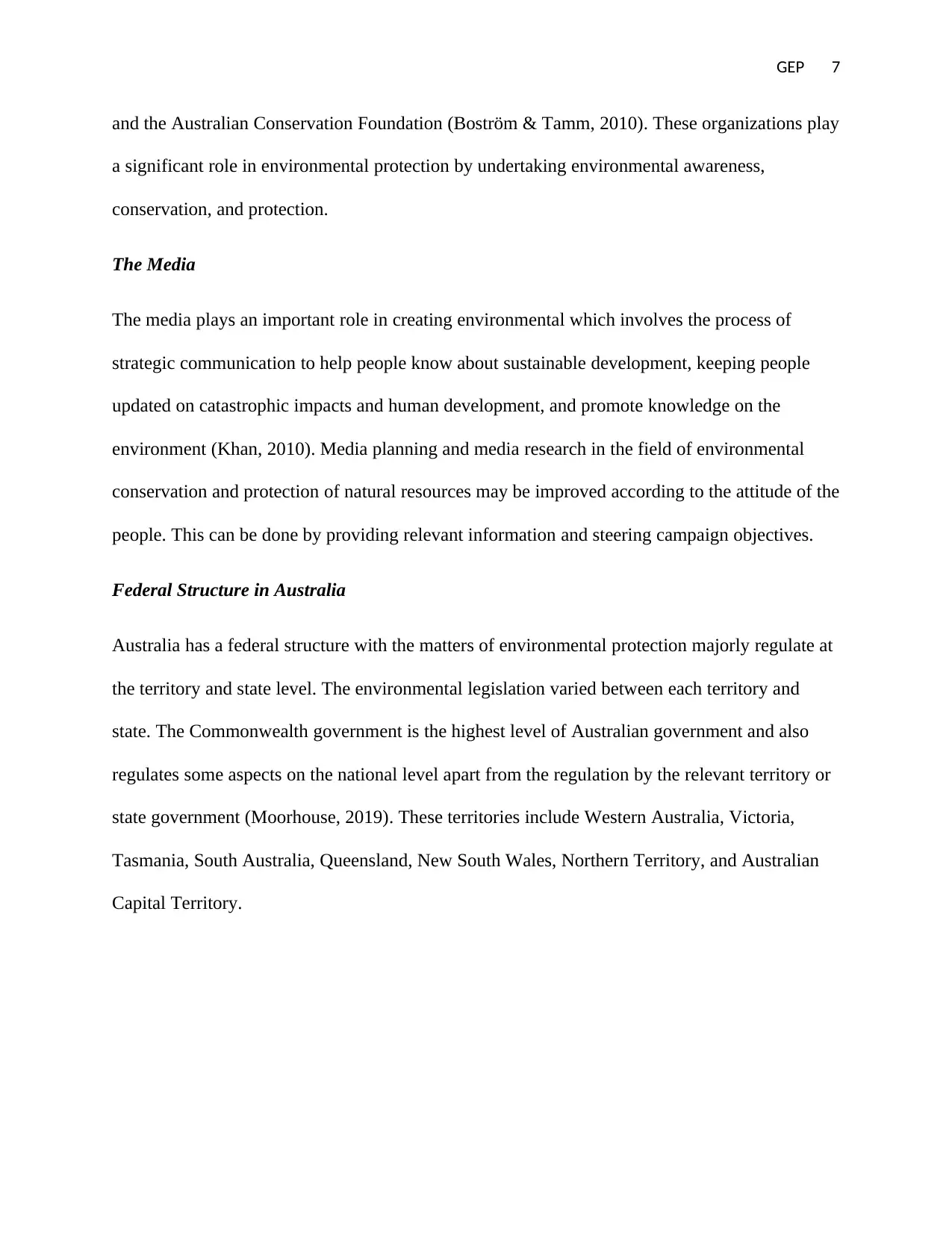
GEP 7
and the Australian Conservation Foundation (Boström & Tamm, 2010). These organizations play
a significant role in environmental protection by undertaking environmental awareness,
conservation, and protection.
The Media
The media plays an important role in creating environmental which involves the process of
strategic communication to help people know about sustainable development, keeping people
updated on catastrophic impacts and human development, and promote knowledge on the
environment (Khan, 2010). Media planning and media research in the field of environmental
conservation and protection of natural resources may be improved according to the attitude of the
people. This can be done by providing relevant information and steering campaign objectives.
Federal Structure in Australia
Australia has a federal structure with the matters of environmental protection majorly regulate at
the territory and state level. The environmental legislation varied between each territory and
state. The Commonwealth government is the highest level of Australian government and also
regulates some aspects on the national level apart from the regulation by the relevant territory or
state government (Moorhouse, 2019). These territories include Western Australia, Victoria,
Tasmania, South Australia, Queensland, New South Wales, Northern Territory, and Australian
Capital Territory.
and the Australian Conservation Foundation (Boström & Tamm, 2010). These organizations play
a significant role in environmental protection by undertaking environmental awareness,
conservation, and protection.
The Media
The media plays an important role in creating environmental which involves the process of
strategic communication to help people know about sustainable development, keeping people
updated on catastrophic impacts and human development, and promote knowledge on the
environment (Khan, 2010). Media planning and media research in the field of environmental
conservation and protection of natural resources may be improved according to the attitude of the
people. This can be done by providing relevant information and steering campaign objectives.
Federal Structure in Australia
Australia has a federal structure with the matters of environmental protection majorly regulate at
the territory and state level. The environmental legislation varied between each territory and
state. The Commonwealth government is the highest level of Australian government and also
regulates some aspects on the national level apart from the regulation by the relevant territory or
state government (Moorhouse, 2019). These territories include Western Australia, Victoria,
Tasmania, South Australia, Queensland, New South Wales, Northern Territory, and Australian
Capital Territory.
Paraphrase This Document
Need a fresh take? Get an instant paraphrase of this document with our AI Paraphraser
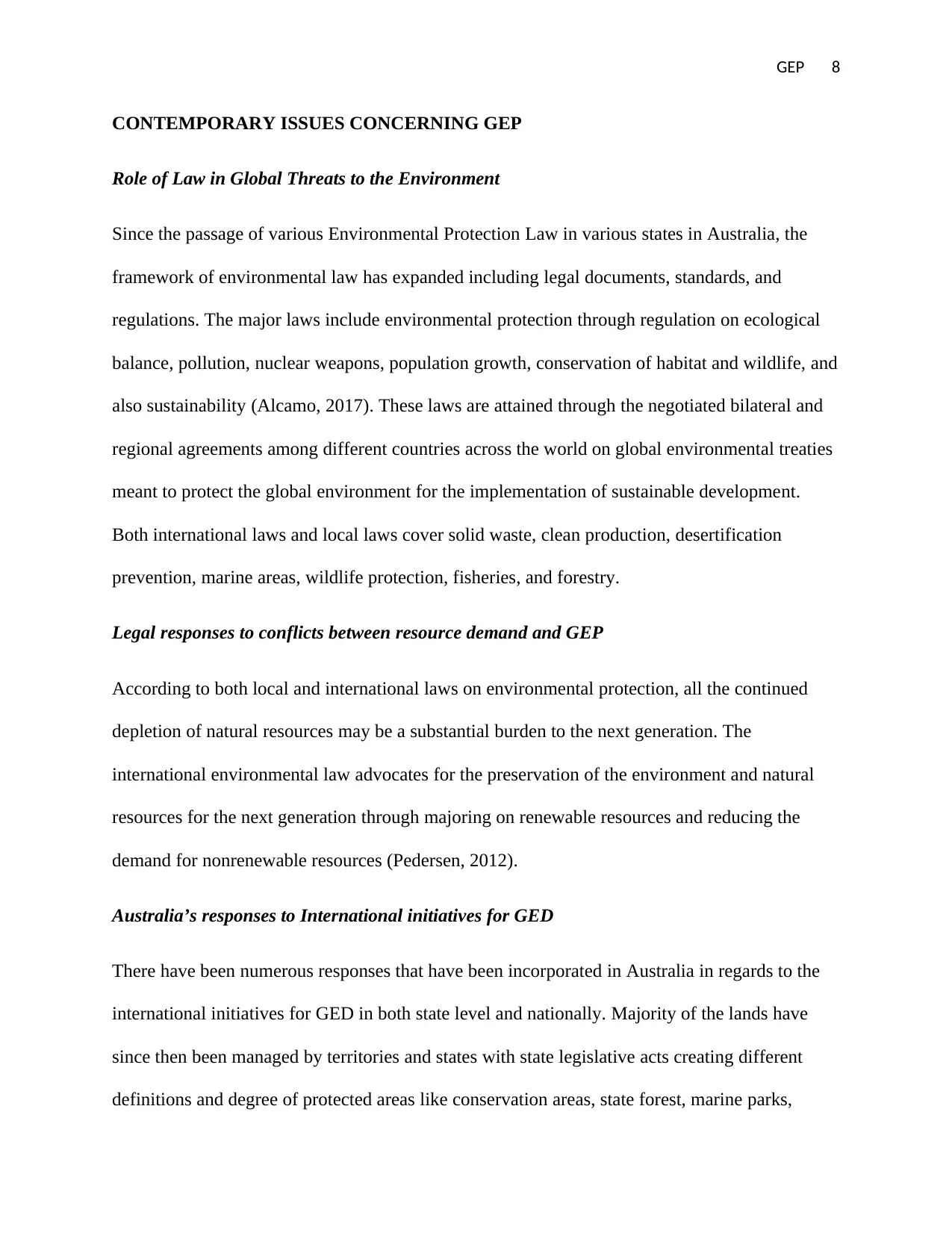
GEP 8
CONTEMPORARY ISSUES CONCERNING GEP
Role of Law in Global Threats to the Environment
Since the passage of various Environmental Protection Law in various states in Australia, the
framework of environmental law has expanded including legal documents, standards, and
regulations. The major laws include environmental protection through regulation on ecological
balance, pollution, nuclear weapons, population growth, conservation of habitat and wildlife, and
also sustainability (Alcamo, 2017). These laws are attained through the negotiated bilateral and
regional agreements among different countries across the world on global environmental treaties
meant to protect the global environment for the implementation of sustainable development.
Both international laws and local laws cover solid waste, clean production, desertification
prevention, marine areas, wildlife protection, fisheries, and forestry.
Legal responses to conflicts between resource demand and GEP
According to both local and international laws on environmental protection, all the continued
depletion of natural resources may be a substantial burden to the next generation. The
international environmental law advocates for the preservation of the environment and natural
resources for the next generation through majoring on renewable resources and reducing the
demand for nonrenewable resources (Pedersen, 2012).
Australia’s responses to International initiatives for GED
There have been numerous responses that have been incorporated in Australia in regards to the
international initiatives for GED in both state level and nationally. Majority of the lands have
since then been managed by territories and states with state legislative acts creating different
definitions and degree of protected areas like conservation areas, state forest, marine parks,
CONTEMPORARY ISSUES CONCERNING GEP
Role of Law in Global Threats to the Environment
Since the passage of various Environmental Protection Law in various states in Australia, the
framework of environmental law has expanded including legal documents, standards, and
regulations. The major laws include environmental protection through regulation on ecological
balance, pollution, nuclear weapons, population growth, conservation of habitat and wildlife, and
also sustainability (Alcamo, 2017). These laws are attained through the negotiated bilateral and
regional agreements among different countries across the world on global environmental treaties
meant to protect the global environment for the implementation of sustainable development.
Both international laws and local laws cover solid waste, clean production, desertification
prevention, marine areas, wildlife protection, fisheries, and forestry.
Legal responses to conflicts between resource demand and GEP
According to both local and international laws on environmental protection, all the continued
depletion of natural resources may be a substantial burden to the next generation. The
international environmental law advocates for the preservation of the environment and natural
resources for the next generation through majoring on renewable resources and reducing the
demand for nonrenewable resources (Pedersen, 2012).
Australia’s responses to International initiatives for GED
There have been numerous responses that have been incorporated in Australia in regards to the
international initiatives for GED in both state level and nationally. Majority of the lands have
since then been managed by territories and states with state legislative acts creating different
definitions and degree of protected areas like conservation areas, state forest, marine parks,

GEP 9
national land, and wilderness. The states also created regulations to regulate and provide general
protection from sound, water, and air pollution. At the national level, the primary environmental
protection legislation is the Environment Protection and Biodiversity Conservation Act 1999
have since then been implemented in response to the international initiations for GED which is
involved with matters of international and national environment concerning cultural heritage,
ecological communities, fauna, and flora. The intergovernmental organizations have also been
implemented in Australia in response to GED which has the responsibility of dealing with
environmental problems by dealing with the people directly at local levels.
Barriers to attaining an international response to GED
The major barriers facing the GED include poor monitoring and evaluation systems to track
various projects or systems that may be unsustainable, unsustainable production and
consumption patterns, growth in population, ignorance to the environmental laws by some
private and government organizations, lack of serious human behaviors in terms of
environmental protection, inadequate interaction between government and civil society
(Moorhouse, 2019). The developing countries are also faced by the problem of inadequate
finance to shift from unsustainable production that has contiguously degraded the environment.
national land, and wilderness. The states also created regulations to regulate and provide general
protection from sound, water, and air pollution. At the national level, the primary environmental
protection legislation is the Environment Protection and Biodiversity Conservation Act 1999
have since then been implemented in response to the international initiations for GED which is
involved with matters of international and national environment concerning cultural heritage,
ecological communities, fauna, and flora. The intergovernmental organizations have also been
implemented in Australia in response to GED which has the responsibility of dealing with
environmental problems by dealing with the people directly at local levels.
Barriers to attaining an international response to GED
The major barriers facing the GED include poor monitoring and evaluation systems to track
various projects or systems that may be unsustainable, unsustainable production and
consumption patterns, growth in population, ignorance to the environmental laws by some
private and government organizations, lack of serious human behaviors in terms of
environmental protection, inadequate interaction between government and civil society
(Moorhouse, 2019). The developing countries are also faced by the problem of inadequate
finance to shift from unsustainable production that has contiguously degraded the environment.
⊘ This is a preview!⊘
Do you want full access?
Subscribe today to unlock all pages.

Trusted by 1+ million students worldwide
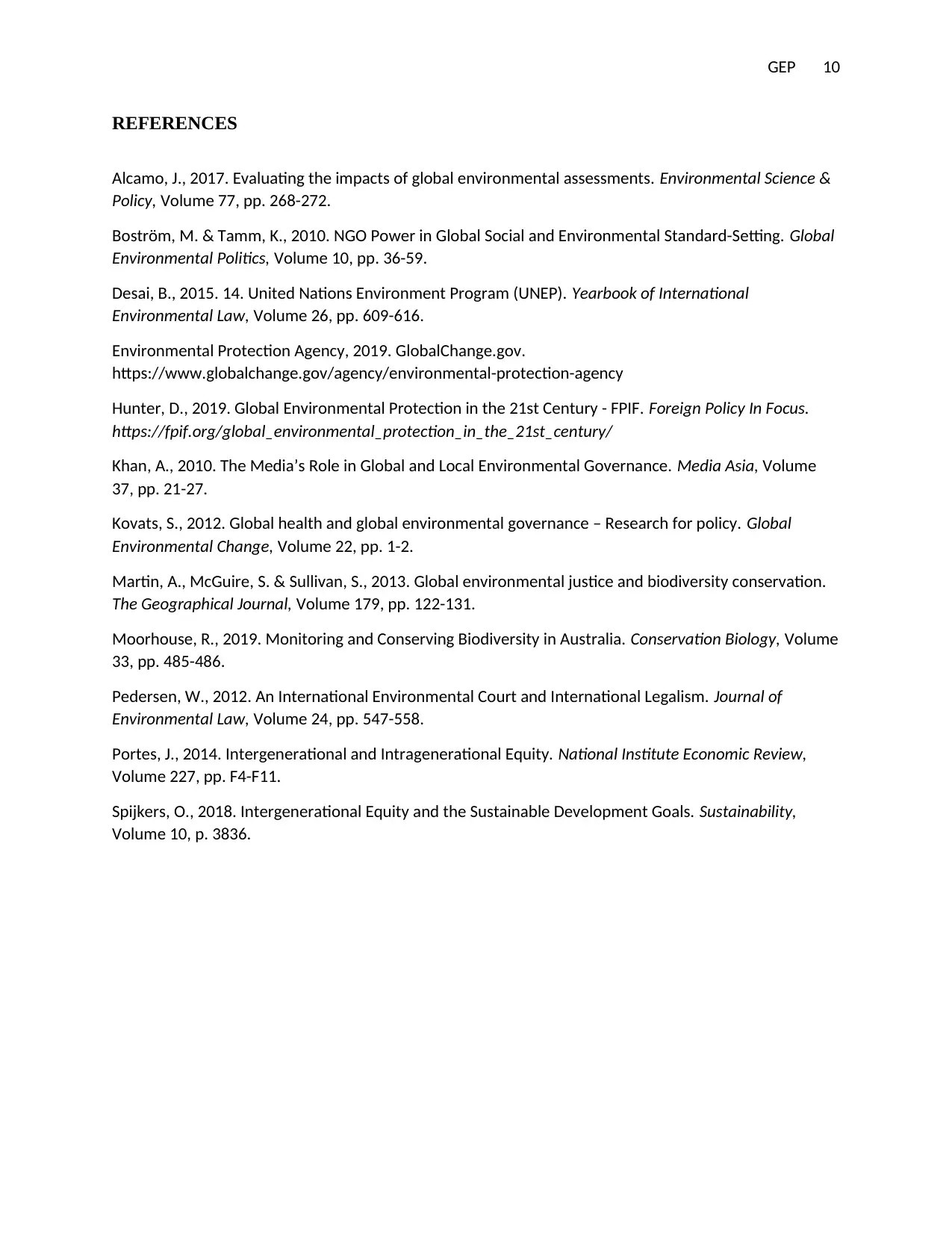
GEP 10
REFERENCES
Alcamo, J., 2017. Evaluating the impacts of global environmental assessments. Environmental Science &
Policy, Volume 77, pp. 268-272.
Boström, M. & Tamm, K., 2010. NGO Power in Global Social and Environmental Standard-Setting. Global
Environmental Politics, Volume 10, pp. 36-59.
Desai, B., 2015. 14. United Nations Environment Program (UNEP). Yearbook of International
Environmental Law, Volume 26, pp. 609-616.
Environmental Protection Agency, 2019. GlobalChange.gov.
https://www.globalchange.gov/agency/environmental-protection-agency
Hunter, D., 2019. Global Environmental Protection in the 21st Century - FPIF. Foreign Policy In Focus.
https://fpif.org/global_environmental_protection_in_the_21st_century/
Khan, A., 2010. The Media’s Role in Global and Local Environmental Governance. Media Asia, Volume
37, pp. 21-27.
Kovats, S., 2012. Global health and global environmental governance – Research for policy. Global
Environmental Change, Volume 22, pp. 1-2.
Martin, A., McGuire, S. & Sullivan, S., 2013. Global environmental justice and biodiversity conservation.
The Geographical Journal, Volume 179, pp. 122-131.
Moorhouse, R., 2019. Monitoring and Conserving Biodiversity in Australia. Conservation Biology, Volume
33, pp. 485-486.
Pedersen, W., 2012. An International Environmental Court and International Legalism. Journal of
Environmental Law, Volume 24, pp. 547-558.
Portes, J., 2014. Intergenerational and Intragenerational Equity. National Institute Economic Review,
Volume 227, pp. F4-F11.
Spijkers, O., 2018. Intergenerational Equity and the Sustainable Development Goals. Sustainability,
Volume 10, p. 3836.
REFERENCES
Alcamo, J., 2017. Evaluating the impacts of global environmental assessments. Environmental Science &
Policy, Volume 77, pp. 268-272.
Boström, M. & Tamm, K., 2010. NGO Power in Global Social and Environmental Standard-Setting. Global
Environmental Politics, Volume 10, pp. 36-59.
Desai, B., 2015. 14. United Nations Environment Program (UNEP). Yearbook of International
Environmental Law, Volume 26, pp. 609-616.
Environmental Protection Agency, 2019. GlobalChange.gov.
https://www.globalchange.gov/agency/environmental-protection-agency
Hunter, D., 2019. Global Environmental Protection in the 21st Century - FPIF. Foreign Policy In Focus.
https://fpif.org/global_environmental_protection_in_the_21st_century/
Khan, A., 2010. The Media’s Role in Global and Local Environmental Governance. Media Asia, Volume
37, pp. 21-27.
Kovats, S., 2012. Global health and global environmental governance – Research for policy. Global
Environmental Change, Volume 22, pp. 1-2.
Martin, A., McGuire, S. & Sullivan, S., 2013. Global environmental justice and biodiversity conservation.
The Geographical Journal, Volume 179, pp. 122-131.
Moorhouse, R., 2019. Monitoring and Conserving Biodiversity in Australia. Conservation Biology, Volume
33, pp. 485-486.
Pedersen, W., 2012. An International Environmental Court and International Legalism. Journal of
Environmental Law, Volume 24, pp. 547-558.
Portes, J., 2014. Intergenerational and Intragenerational Equity. National Institute Economic Review,
Volume 227, pp. F4-F11.
Spijkers, O., 2018. Intergenerational Equity and the Sustainable Development Goals. Sustainability,
Volume 10, p. 3836.
1 out of 10
Related Documents
Your All-in-One AI-Powered Toolkit for Academic Success.
+13062052269
info@desklib.com
Available 24*7 on WhatsApp / Email
![[object Object]](/_next/static/media/star-bottom.7253800d.svg)
Unlock your academic potential
Copyright © 2020–2025 A2Z Services. All Rights Reserved. Developed and managed by ZUCOL.





